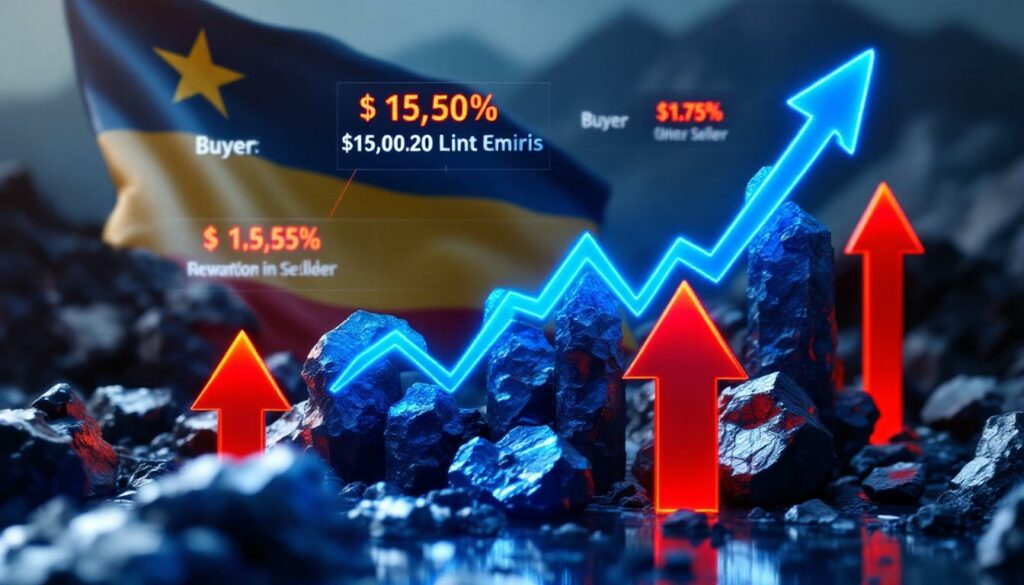What's Driving the Current Cobalt Intermediate Price Increases?
The spot price of cobalt intermediate products has been experiencing a notable upward trajectory in recent weeks. This surge comes amid several critical market developments that have significantly altered the supply-demand equilibrium in the global cobalt market.
Supply Disruptions Creating Market Pressure
A major disruption occurred when a significant mining operation declared force majeure in early July 2025, immediately triggering ripple effects throughout the supply chain. This unexpected announcement has dramatically reshaped market dynamics, creating immediate supply constraints that weren't anticipated in previous market forecasts.
"A miner announced force majeure this week, further strengthening the bullish sentiment of mines and traders," reports Shanghai Metal Market (SMM) in their July 2025 weekly review.
In response to this uncertainty, most suppliers have implemented strategic quotation suspensions. The few enterprises still providing quotations have significantly raised their price points, capitalizing on the supply shortage. This calculated approach by suppliers has further amplified price pressures in an already constrained market.
The Democratic Republic of Congo's extension policy implementation has emerged as another critical factor driving prices upward. This regulatory change is expected to create substantial raw material shortages for Chinese processors and manufacturers in the coming months, adding a layer of structural pressure to the market.
Market Sentiment Among Key Players
The force majeure declaration has fundamentally altered market psychology, with a strengthened bullish outlook now prevalent among mines and trading companies. This sentiment shift represents a significant change from the cautious optimism that characterized the market earlier in the year.
Meanwhile, smelters are adopting a distinctly different approach. Facing production cost losses and weak downstream demand, most have implemented a wait-and-see strategy. Many have temporarily suspended procurement activities altogether, choosing instead to focus on consuming existing inventory rather than purchasing at elevated prices.
Inventory management strategies have become increasingly sophisticated across the industry. Companies with substantial stockpiles are selectively delaying purchases, while those with limited inventory are facing difficult decisions about when and how to enter the market.
A significant impediment to market fluidity is the widening gap between buyer and seller price expectations. As one market participant noted, "Actual transactions remained difficult due to significant price differences between buyers and sellers." This disparity has created a situation where price inquiries abound but completed transactions remain scarce.
How Are Production Challenges Affecting the Cobalt Supply Chain?
The cobalt intermediate products market is experiencing a complex interplay of production challenges that extend throughout the supply chain, creating both immediate pressures and longer-term structural concerns.
Smelter Operational Difficulties
Smelters find themselves in an increasingly precarious financial position, caught between rising raw material costs and weak downstream demand. This cost-price squeeze has resulted in production losses for many operations, with profit margins compressed to unsustainable levels in some cases.
According to SMM research, "Smelters faced difficulties such as production cost losses and weak downstream demand." These twin pressures have forced many facilities to make difficult operational decisions, including temporary production curtailments and procurement suspensions.
Inventory management has become a critical survival strategy. The majority of smelters have pivoted to consuming existing stockpiles rather than purchasing new materials at current price points. This calculated approach allows them to postpone major procurement decisions while waiting for market conditions to stabilize.
The market is witnessing a bifurcated response based on inventory positions:
- Well-stocked operations: Focusing on inventory consumption and avoiding market purchases
- Low-inventory facilities: Selectively making price inquiries but struggling to complete transactions
- Critical-level inventory operations: Forced to enter the market despite unfavorable pricing
Transaction difficulties persist due to substantial price disparities between what buyers can afford to pay and what sellers are willing to accept. This gap has created a situation where price discovery is impaired, and market activity remains sluggish despite clear supply needs.
Raw Material Availability Concerns
The cobalt intermediate supply chain faces mounting concerns about future raw material availability, particularly in Chinese markets. The DRC's extension policy implementation is creating anticipation of significant supply constraints that could further destabilize the market.
This regulatory shift comes at a particularly challenging time, as processing facilities are already grappling with elevated input costs and operational difficulties. The combination of policy changes and existing market tightness creates a compounding effect on price pressures.
Upward price momentum continues to build despite evident demand challenges. This seemingly contradictory dynamic highlights the dominant influence of supply-side factors in the current market environment, where availability concerns outweigh immediate consumption patterns.
Strategic inventory management has become essential for survival in this volatile market. Companies throughout the supply chain are reassessing optimal inventory levels, procurement timing, and hedging strategies to navigate the current uncertainty.
Quotation strategies are evolving rapidly in response to market developments. Suppliers are becoming increasingly selective about when and to whom they provide price quotes, creating an additional layer of market opacity that further complicates transaction completion.
What Are the Demand-Side Dynamics in the Cobalt Market?
While supply constraints dominate recent headlines, equally important demand-side factors are playing a crucial role in shaping the cobalt intermediate products market. Understanding these consumption patterns is essential for anticipating future price movements and market equilibrium.
Downstream Demand Challenges
The cobalt market is experiencing noticeably weakening consumption patterns across several end-use sectors. This softening demand comes at a particularly challenging time, as it coincides with supply disruptions that would typically drive prices even higher in a robust demand environment.
Price sensitivity has emerged as a major factor inhibiting demand growth. As cobalt intermediate product prices increase, manufacturers of batteries and other downstream products face difficult decisions about production volumes, alternative material usage, and end-product pricing.
There is growing concern about potential demand destruction if prices remain elevated for an extended period. Industry analysts are closely monitoring several key indicators:
- Substitution rates in battery chemistry formulations
- Production schedule adjustments at major battery manufacturers
- Electronic product design modifications to reduce cobalt usage
- Industrial application reformulations to minimize cobalt requirements
The market is witnessing a delicate balancing act between supply constraints pushing prices higher and demand preservation concerns that may eventually create price resistance. This tension creates a challenging environment for price forecasting and strategic planning.
Buyer Response Strategies
In response to current market conditions, buyers are implementing a range of strategic approaches to manage costs and ensure supply security. Temporary procurement suspensions have become increasingly common, with many purchasers pausing new acquisitions until greater price clarity emerges.
As SMM reports, smelters have "temporarily suspended procurement and focused on consuming their own inventory." This widespread strategy reflects both financial prudence and a calculated bet that prices may stabilize or decrease in the coming weeks.
Internal inventory utilization has been prioritized over new purchases across the industry. Companies with adequate stockpiles are strategically drawing down these reserves while monitoring market developments for optimal reentry points.
Price inquiry activities have increased significantly, but this heightened interest rarely translates into completed transactions. Buyers are gathering market intelligence and establishing price discovery mechanisms without committing to purchases at current levels.
Strategic positioning for anticipated market developments has become a critical focus. Forward-thinking organizations are developing contingency plans for multiple price scenarios while ensuring sufficient material availability for essential production requirements.
Market Outlook: What Can We Expect for Cobalt Intermediate Products?
Forecasting price movements in the volatile cobalt intermediate products market requires careful analysis of multiple intersecting factors. While supply disruptions continue to dominate headlines, evolving demand patterns and strategic responses will play equally important roles in determining market direction.
Price Trajectory Analysis
The continued upward momentum in cobalt intermediate product prices appears well-supported by fundamental supply constraints. The force majeure declaration, quotation suspensions, and anticipated raw material shortages from DRC policy changes create a robust foundation for sustained price strength.
According to SMM analysis, "China's cobalt intermediate products will still face a shortage of raw materials in the future, and there is upward momentum in prices." This supply-driven perspective suggests continued price support in the near term.
However, potential price ceiling effects from demand destruction cannot be dismissed. As SMM cautions, "attention needs to be paid to the inhibition of downstream demand caused by the increase in raw material prices." This counterbalancing force may eventually create resistance levels that limit further price appreciation.
Market equilibrium challenges are likely to persist in the near term as supply constraints and demand responses continue to evolve. The timing and magnitude of equilibrium restoration remain uncertain, creating a challenging environment for strategic planning and risk management.
Price volatility is expected to remain elevated as the market adjusts to these new conditions. Rapid price movements in both directions may occur as new information about supply availability, demand responses, and regulatory developments enters the market.
Strategic Considerations for Market Participants
Inventory management has become increasingly critical for all market participants. Optimal inventory levels must balance cost considerations against supply security, with different strategies appropriate for different positions in the supply chain.
Timing considerations for procurement activities have taken on renewed importance. Strategic purchasing decisions must account for both immediate price levels and expectations about future market movements, creating complex decision matrices for procurement teams.
Risk assessment needs for supply chain planning have intensified in the current environment. Companies must evaluate exposure to both price volatility and physical supply disruptions, implementing appropriate hedging and diversification strategies where possible.
Market participants face the ongoing challenge of balancing short-term market conditions with long-term supply security objectives. This balance requires sophisticated analysis of market fundamentals, regulatory developments, and technological trends affecting both supply and demand.
A multi-scenario planning approach has become essential for navigating this uncertain landscape. Forward-thinking organizations are developing contingency plans for various potential market outcomes, ensuring operational resilience regardless of how market conditions evolve.
FAQ About the Cobalt Intermediate Products Market
What caused the recent price increases in cobalt intermediate products?
The price increases stem from multiple factors including a force majeure declaration by a major producer in July 2025, the DRC's extension policy affecting raw material availability, and strategic quotation suspensions by suppliers responding to market uncertainty. As SMM reports, "a miner announced force majeure this week, further strengthening the bullish sentiment of mines and traders." These supply-side constraints have created significant upward pressure on prices despite relatively weak demand conditions.
How are smelters responding to the current market conditions?
Smelters are primarily suspending new procurement activities, focusing on consuming existing inventory, and carefully monitoring market developments before committing to purchases. According to SMM, "they temporarily suspended procurement and focused on consuming their own inventory." This cautious approach reflects both production cost pressures and weak downstream demand, creating a situation where smelters are reluctant to purchase at current price levels but may be forced to enter the market if inventory levels become critically low.
What impact might continued price increases have on the market?
Sustained price increases could potentially inhibit downstream demand, creating a balancing effect in the market. As SMM notes, "attention needs to be paid to the inhibition of downstream demand caused by the increase in raw material prices." This potential demand destruction represents a limiting factor on price appreciation, as manufacturers may reduce cobalt usage, reformulate products, or curtail production if input costs remain elevated for an extended period.
Are actual transactions occurring in the current market?
Transactions remain difficult to complete due to significant price expectation gaps between buyers and sellers. SMM confirms that "actual transactions remained difficult due to significant price differences between buyers and sellers." Most market activity is currently limited to price inquiries rather than completed deals, with buyers gathering market intelligence but hesitating to commit at current price levels. This transaction hesitancy creates additional market opacity and complicates price discovery mechanisms.
Comparative Market Analysis: Cobalt Products Sector
The cobalt market encompasses multiple product segments with distinct dynamics and influencing factors. Understanding these differences provides valuable context for analyzing the intermediate products sector.
| Market Segment | Current Price Trend | Supply Status | Demand Dynamics | Key Influencing Factors |
|---|---|---|---|---|
| Cobalt Intermediate Products | Upward | Constrained | Weakening | Force majeure, DRC policy |
| Cobalt Sulphate | Fluctuating | Balanced | Stable | Downstream battery demand |
| Refined Cobalt | Stable to Rising | Adequate | Moderate | Intermediate product pricing |
| Cobalt Alloys | Stable | Sufficient | Consistent | Industrial manufacturing needs |
The intermediate products segment stands out for its supply constraints and upward price momentum despite weakening demand. This divergence from other segments highlights the unique supply-side pressures affecting this particular market.
While the cobalt sulphate market maintains more balanced conditions with stable demand from battery manufacturers, its pricing increasingly reflects developments in the intermediate products segment. This connection demonstrates the interconnected nature of various cobalt market segments.
The refined cobalt market shows moderate demand patterns with adequate supply, creating a more stable price environment than the volatile intermediate products segment. However, continued pressure in intermediate products will eventually influence refined cobalt pricing through input cost effects.
Cobalt alloys benefit from consistent demand in industrial applications with sufficient supply availability. This segment demonstrates the least correlation with intermediate product market dynamics, reflecting its distinct end-use applications and supply sources.
Market Insight: The divergence between rising intermediate product prices and downstream demand weakness creates a potential market imbalance that participants should monitor closely in their strategic planning.
Key Factors to Monitor in the Cobalt Intermediate Market
Market participants must remain vigilant about several critical factors that could significantly impact the trajectory of cobalt intermediate products in the coming months. Proactive monitoring of these indicators will enhance strategic decision-making capabilities.
Supply-Side Indicators
Additional force majeure declarations or resolutions could dramatically alter market dynamics. Participants should establish monitoring mechanisms for production disruption announcements and maintain awareness of operational status at major mining facilities.
Changes to DRC policy implementation or enforcement represent a critical variable for future supply availability. As SMM notes, the market is "influenced by the DRC's extension policy," making regulatory developments in this key producing region particularly significant for price forecasting.
Quotation strategy shifts among major suppliers offer valuable early indicators of market direction. The current pattern of suspended quotations could either intensify or reverse, providing insight into supplier confidence and price expectations.
New production capacity announcements or delays will impact medium-term supply expectations. Project timelines, investment decisions, and operational ramp-up schedules at major developments should be carefully tracked for potential market impacts.
Supply chain logistics challenges, including transportation disruptions or border restrictions, could further complicate material availability beyond the mine-level constraints currently dominating market attention.
Demand-Side Signals
Downstream consumption pattern changes deserve close attention, particularly as SMM cautions about "the inhibition of downstream demand caused by the increase in raw material prices." Early indicators of demand destruction or resilience will provide critical insight for price forecasting.
Battery sector procurement strategy adjustments offer a window into how this crucial end-use sector is responding to current market conditions. Changes in purchasing patterns, inventory policies, or material specifications will impact overall market balance.
Price sensitivity thresholds in end-use applications remain somewhat uncertain. Monitoring manufacturer responses to continued price increases will help establish the point at which demand destruction begins to counterbalance supply constraints.
Inventory levels throughout the supply chain represent a key variable in market dynamics. The current strategy of inventory consumption rather than procurement cannot continue indefinitely, creating potential for sudden demand increases when restocking becomes necessary.
Technology developments in battery chemistry and other applications could significantly impact cobalt demand patterns. Breakthroughs in low-cobalt or cobalt-free technologies would fundamentally alter long-term market expectations.
Strategic Consideration: Market participants should carefully balance short-term price opportunities against long-term supply security and relationship maintenance during this volatile period.
The spot price of cobalt intermediate products continues to navigate complex crosscurrents of supply constraints and demand uncertainty. While supply-side factors currently dominate price formation, the potential for demand responses creates a dynamic environment requiring sophisticated analysis and strategic flexibility. With the Cobalt Blue expansion adding further complexity to the supply landscape, market participants must remain vigilant about both immediate price movements and longer-term structural trends affecting the market.
Understanding how cobalt fits into the broader energy transition outlook is also essential for strategic planning. As battery technology evolves and clean energy demands grow, cobalt's role as a critical mineral will continue to shape market dynamics. Furthermore, recent iron ore trends demonstrate how similar commodity markets respond to supply-demand imbalances, offering valuable comparative insights.
The potential for value addition through mineral beneficiation benefits presents strategic opportunities for producing nations seeking to capture more value from their resources. Finally, understanding correlations with the gold market surge can provide additional context for investors seeking to balance exposure across multiple commodity markets during periods of volatility.
Looking to Capitalise on the Next Major Mineral Discovery?
Stay ahead of the market with Discovery Alert's proprietary Discovery IQ model, which provides instant notifications on significant ASX mineral discoveries and transforms complex data into actionable investment insights. Visit the Discovery Alert discoveries page to understand how major mineral discoveries like cobalt can generate substantial returns and begin your 30-day free trial today.




